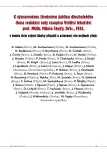-
Medical journals
- Career
The most common heart valve diseases: aortic stenosis and mitral regurgitation. A few comments on guidelines and recommendations by societies of cardiology
Authors: R. Čerbák
Authors‘ workplace: Centrum kardiovaskulární a transplantační chirurgie Brno, ředitel doc. MUDr. Petr Němec, CSc.
Published in: Vnitř Lék 2009; 55(9): 784-787
Category: 80th Birthday - prof. MUDr. Miloš Štejfa, DrSc., FESC
Overview
Recommendations of professional societies, frequently called guidelines as per the English translation, provide help to the general practice as well as specialized physicians. These are recommendations, not a legislative norm. Societies of cardiology have issued 3 new guidelines over the recent years; American ACC/AHA in 2006 and European ESC and Czech CSC in 2007. Guidelines for diagnostics and therapy are presented as Class I to III according to the suitability of the procedure and the level of evidence is classified in groups A to C. Emphasised is the effort of societies of cardiology to provide unbiased guidelines. They request the authors to provide a statement confirming they are not in any way related to any organization, institution or company that could be at present or in the future considered as a conflict of interests. Mentioned is the rapid growth of knowledge that does not allow the guidelines to consider the latest advances to trans-catheter therapy of the both most frequently occurring valve disorders.
Key words:
aortic stenosis – mitral regurgitation – guidelines – trans-catheter valve disorder corrections
Sources
1. Bonow RO, Carabello BA, Chatterjee MB et al. ACC/AHA 2006 Guidelines for the Management of Patients with Valvular Heart Disease: Executive Summary. J Am Coll Cardiol 2006; 48 : 598–675.
2. Vahanian A, Baumgartner H, Bax J et al. Guidelines on the management of valvular heart disease. The Task Force on the Management of Valvular Heart Disease of the European Society of Cardiology. Eur Heart J 2007; 28 : 230–268.
3. Popelová J, Benešová M, Brtko M et al. Doporučené postupy pro diagnostiku a léčbu chlopenních srdečních vad v dospělosti. Cor Vasa 2007; 49 (Suppl): 6–46.
4. Prendergast BD, Banning AP, Hall RJ. Valvular Heart Disease: Recommendations for investigation and management. Summary of guidelines produced by a working group of the British Cardiac Society and the Research Unit of the Royal College of Physicians. J R Coll Physicians Lond 1996; 30 : 309–315.
5. Čerbák R. Doporučené postupy pro diagnostiku a léčbu chlopenních srdečních vad v dospělém věku. Cor Vasa 1997; 39: K165–K171.
6. Frídl P, Marek T, Čerbák R et al. Doporučené postupy pro diagnostiku a léčbu nemocných s chlopenní vadou v dospělosti. Cor Vasa 2000; 42: K82–K86.
7. Endrys J. Invazivní hemodynamické metody. Hradec Králové: Nukleus 2005.
8. Zajarias A, Cribier AG. Outcomes and Safety of Percutaneous Aortic Valve Replacement. J Am Coll Cardiol 2009; 53 : 1829–1836.
9. Vojáček J. První katetrizační implantace aortálních chlopní v České republice. Interv Akut Kardiol 2009; 8 : 6–8.
10. Vahanian A, Alfieri O, Al-Attar N et al. Transcatheter valve implantation for patients with aortic stenosis: a position statement from the European association of cardio-thoracic surgery (EACTS) and the European Society of Cardiology (ESC), in collaboration with the European Association of Percutaneous Cardiovascular Interventions (EAPCI). EuroIntervention 2008; 4 : 193–199.
11. Čerbák R et al: Nejčastější chlopenní vady. Praha: Galén 2007.
Labels
Diabetology Endocrinology Internal medicine
Article was published inInternal Medicine

2009 Issue 9-
All articles in this issue
- Myocarditis
- Heart transplantation
- Hypertension combination therapy with rennin-angiotenzin system blockers
- Cholesterol levels according to age
- Echocardiography in patients with ischemic heart disease
- Transplantation of haematopoietic cells
- B-cell chronic lymphocytic leukaemia and the similar states
- Tako-tsubo cardiomyopathy
- Reducing food salt content – a neglected approach to hypertension prevention and treatment in the population
- To treat or not to treat with statins patients with chronic heart failure?
- How to improve response to cardiac resynchronization therapy?
- Monitoring of cardiovascular risk factors in patients with diabetes type 2
- Prediabetes – 2009
- Some current views on chronic ischemic heart disease
- Target values in hypertension treatment. Will they apply in older patients with hypertension, diabetics and in patients with IHD?
- AT1-blockers in the treatment of hypertension
- The importance of autologous transplantation in multiple myeloma
- Liver cirrhosis and its treatment
- Surgical treatment of pulmonary embolism
- The most common heart valve diseases: aortic stenosis and mitral regurgitation. A few comments on guidelines and recommendations by societies of cardiology
- Diabetes and vascular diabetic disease
- Internal Medicine
- Journal archive
- Current issue
- Online only
- About the journal
Most read in this issue- Cholesterol levels according to age
- B-cell chronic lymphocytic leukaemia and the similar states
- Liver cirrhosis and its treatment
- Transplantation of haematopoietic cells
Login#ADS_BOTTOM_SCRIPTS#Forgotten passwordEnter the email address that you registered with. We will send you instructions on how to set a new password.
- Career

